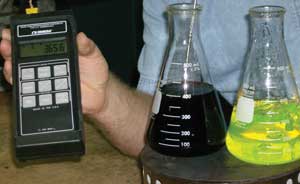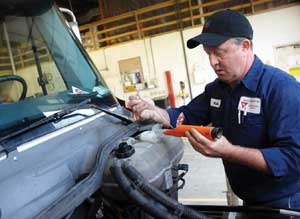arge of SCA necessary to protect against cavitation and corrosion. This coolant technology can be a “fill for life” if properly maintained and SCA levels are tested at every PM interval.
Organic acid technology coolants virtually eliminate the need for coolant maintenance. OAT coolants utilize organic carboxylate acids for corrosion protection. There are several different blends (OAT, OAT-NAP free, NOAT, HOAT) that do not require chemical supplementation for up to 300,000 miles in some cases, and cannot be diluted more than 10% to 15% with other coolants or water.
Coolant and additive suppliers offer a range of products to meet fleets. More information can be found on the following websites:
BG Products: www.bgprod.com
Chevron: www.deloperformance.com
Kost USA: www.kostusa.com
Old World Industries: www.oldworldind.com
Penray: www.penray.com
Shell: www.shell.com
Waterless alternative
Formulated especially for newer heavy-duty diesel engines that operate at higher temperatures, Evans Waterless Heavy Duty Coolant (HDC) (www.evanscooling.com) is a proprietary and patented blend of synthetic materials, soluble additives, and no water.

Water has superior thermal conductivity in its liquid state, the company noted, but once it turns to vapor it loses 96% of its thermal conductivity. Its low boiling point (between 212°F to 220°F) becomes the failure temperature of traditional cooling systems. In addition, localized boiling causes vapor pockets that interrupt heat transfer.
Evans Waterless HDC, by contrast, boils at 375° F. An engine operating temperature of 230°F is more than 100°F colder than the boiling point of Evans HDC, the company said, adding its Waterless Coolants also do not freeze. At extreme cold temperatures, the coolant contracts and becomes thick, but does not become solid or expand like antifreeze containing water.
Evans also pointed out that the energy it takes to maintain coolant temperatures below the boiling point of water is a huge waste of fuel. The fans of heavy-duty diesel engines draw considerable horsepower so minimizing fan operation leads directly to significant fuel savings. With its Waterless Coolant, the company adds, fuel savings can result from increasing thermostat temperatures to 205˚ F and reducing fan run time by raising the fan-on temperature to 230˚ F.
Recent long-term fuel economy testing with Veolia Environmental Services showed an overall improvement of over 5% with Evans HDC, according to the company. Fuel economy testing with the Department of Sanitation in New York City also showed an overall improvement of more than 5.5%. SAE Type II testing at PAVE Research Institute using Evans Waterless Coolant with 215°F thermostats proved a fuel economy improvement in excess of 3%.
Evans noted how its Waterless HDC can cut maintenance costs. The waterless formula avoids corrosion and electrolysis between dissimilar metals within the cooling system, and the absence of vapor reduces system pressure. In Waterless HDC, there are no abrasive additive deposits, so pump seals last longer and hoses and gaskets will not deteriorate. The costly problems of cylinder liner cavitation erosion can be avoided by using Evans HDC, according to the maker. Evans also added that its Waterless Coolants last the life of the engine, so replacement and disposal costs are eliminated.
An Evans Waterless Coolant installed in a Class 8 tractor in 1990, when the truck was new, is still in use, demonstrating its long-term benefit without ever having to be replaced. For its entire history, the truck has had thermostats set at 215°F and a 230˚ F fan-on switch setting. After nearly a million miles, cylinder liners, pistons and valves are original and the truck is getting more than 7 MPG, Evans said.
Cooling System Maintenance
Improper coolant flow is the reason for nearly half of all early engine failures. It follows that reliable coolant products are necessary for preventing dirt, rust, scale and other contaminants from creating hot spots and damaging an engine’s cooling system.

Filtered coolant is the key to continued engine protection. Filters remove contaminants and maintain cooling system balance, helping keep today’s hotter-running engines cool and thereby reducing downtime and maintenance costs.
To help reduce maintenance costs, the practice of recycling used coolant was introduced in the late 1980s. Recycling can be performed in the shop with the use of a recovery type machine attached to the engine, or a service provider offering the service can pick up used coolant. Different types of recycling procedures are itemized in Technology & Maintenance Council (TMC) Recommended Practice 326—Recycling Engine Coolant.
The more sophisticated recycling processes like reverse osmosis, ion exchange and distillation can provide quality recycled coolants. There should be no performance compromise when compared to high quality, virgin stock coolants. It is important that the recycled coolant can be re-inhibited to meet TMC RP 329, RP 364, and ASTM D-6210 specifications.
According to K-Line Special Service Tools (klineind.com/AGCO-special-service-tools.html), flushing, pressure testing, and refilling the cooling system is considered routine maintenance. However, with the introduction of EGR and a variety of coolants, this task has become anything but routine. Recently introduced by K-Line is its KL34000 Coolant Management System, which comes with adapters that use standard shop air to create regulated pressure and a powerful vacuum. The regulated pressure forces the coolant out of the entire system.
After the coolant is out, closing a single valve allows for a pressure test to be performed, diagnosing the integrity of the system. Once any necessary repairs are made, the pressure module is swapped out for the vacuum module. The vacuum creates negative pressure throughout the cooling system, drawing the coolant through the entire system from the bottom up and eliminating the possibility of air pockets forming.
In today’s lower emissions engines, coolant temperatures have risen dramatically. These higher temperatures can lead to degradation of the coolant, which can only be detected through a sample analysis performed by a reputable laboratory.
RPs for cooling system maintenance
Coolants should be used in accordance with OEM recommendations and purchased pre-mixed with water from a manufacturer or mixed in the field using de-ionized or distilled water only to ensure the best performance.
Perform a visual examination of the coolant to ensure it is the proper color and free from debris, rust and lubricating oil. Drain, flush and refill if visual inspection indicates any contamination.
Perform visual inspections of cooling systems. Check to make sure the radiator air intake is free of debris and obstructed air flow. Examine hoses for pliability and ensure they are a safe distance from hot engine components. Check hose clamps for coolant leakage and proper tension. Also inspect for indications of a faulty radiator cap, which can lead to coolant breakdown and boil-over.
Use a calibrated refractometer to determine freeze point and glycol concentration of the coolant in the reservoir or storage, and coolant test strips to determine additive levels.
When maintaining systems filled with conventional coolant, it is vital to check for proper SCA level, pH and freeze point protection. This can be accomplished with the use of all-in-one coolant test strips. Be sure to test engine coolant at each scheduled service interval to maintain proper cooling system protection.
Treat coolant with proper SCA products. SCA contains inhibitors designed to prevent generalized corrosion, nitrite for protection against cavitation erosion, scale inhibitors that keep hard water scale from depositing on engine surfaces, and buffering agents to reduce the acidity of the coolant.













